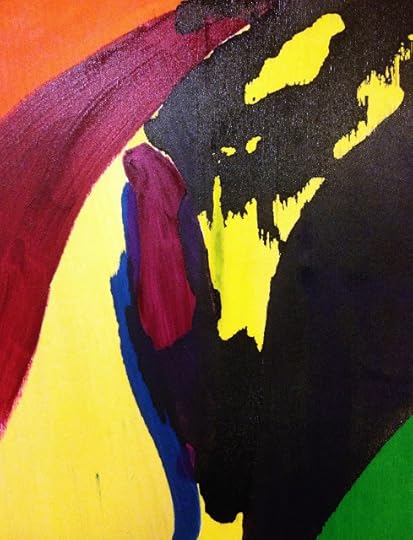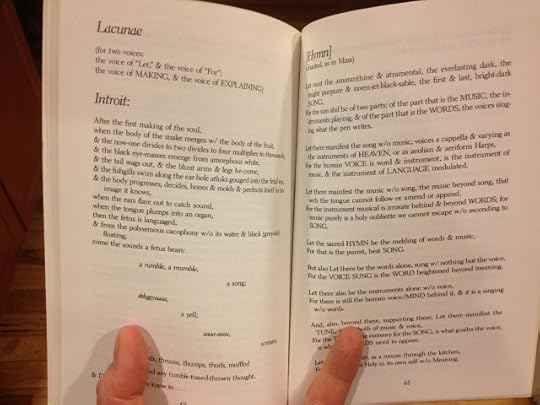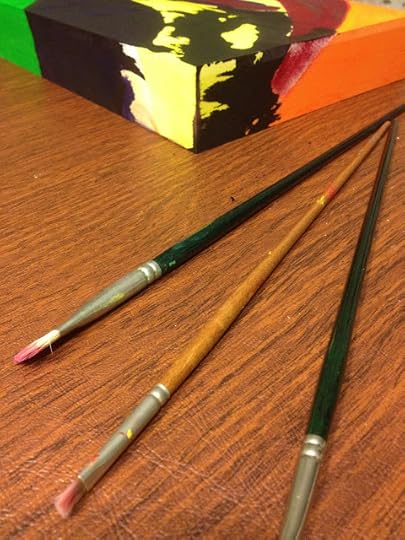What I Once Will Be
 Geof Huth, A Draft of an Inking (19 February 2013)
Geof Huth, A Draft of an Inking (19 February 2013) I have not been productive of late. At least not in any way I'd like to be. The act of creating has become not difficult but rare. It's not that I cannot make anything. It is that I have no will to make. Only desire. And, as every melodrama teaches us, desire is what destroys us. Desire without the calming force of fulfillment causes tension even, so it seems, in a person almost devoid of productive drive.
So tonight I forced myself to work on a poem, a visual poem, the idea for which has been rattling inside my head for a couple of months but the outlines of which are still vague. I learn what I want to create through the process of creation. No amount of pre-planning can prepare me for whatever will happen.
I unwrapped a canvas tonight, a basswood canvas attached to a deep pine frame. My idea here was to paint on the canvas with ink. The photograph above might seem to be of a painting, but it is an inking. Since I'm a writer more than an artist, I draw with ink, I paint with ink. As I began painting this, I had no idea what I was trying to do, but I found myself making fields of color vaguely in the manner of Sonia Delaunay in her visual poetic collaboration with Blaise Cendrars entitled "La prose du Transsibérien et de la Petite Jehanne de France."
Since I had, at that point, an idea of what I was doing, I spilled a large quantity of ink over the beautiful swath of yellow I had painting onto the board, and now I have to rethink my plans. But I'm enjoying the imperfections of the spill. I just remain unsure how I'm going to add text: pen, rubberstamp, collage, gouging, maybe all of them?

Also today, I received what I might consider my contributor's copy of a journal publishing one of my poems back in 1988: Studia Mystica, Volume XI, Number 4. I never received my copy because I'd moved from Syracuse before it arrived, and after (it seems) my mail was no longer being forwarded. I've looked for this for years but never found anything. Until last week, when I found a copy online and bought it right away. What this allowed me was the opportunity to read I poem I'd written a quarter of a century ago, a long poem that I'd never finished, one that was supposed to include a number of handdrawn visual poems within it.

As I read this over again tonight, I saw all the influences I forgot were there (Gerard Manley Hopkins, Vachel Lindsay, the Catholic Mass), but I didn't really feel the full effect of the influence I'd remembered (Christopher Smart's Jubilate Agno). Yet there was something else in this poem: me. I could see my over-concern for sound, my interest in the visual, my interest in language as a physical product of work, something palpable. I could still write some of these strange twisted lines today. I have remained, to a great degree, the same poet, just older, maybe richer in some ways.
I wrote these lines, this poem, in graduate school at Syracuse University, in the class for us handful of poets. As I looked back at them tonight, I realized how different I was from the rest of them, two of them quite fine poets. Most of them told stories of living; I played with language. My game was language as music and language as visual art. I was more interested in drama than narrative, in cacophony than syntax.
I loved syntax. I just wasn't a vassal of it. My poetry has always been concerned with thepalpable modification of the physical stuff of language. Even back when I was vaguely conservative and reserved in my definition of poetry, I was working somewhere separate from my colleagues, on a different continent, but still in the same hemisphere.
This was years before I had painted with ink for so long that I could find myself at the end of an evening with a wooden canvas covered with the unlettered shapes of ink and could think of that fully visual creation as simply a draft of a poem I had not yet imaged the shape of.

ecr. l'inf.
Published on February 19, 2013 19:47
No comments have been added yet.



